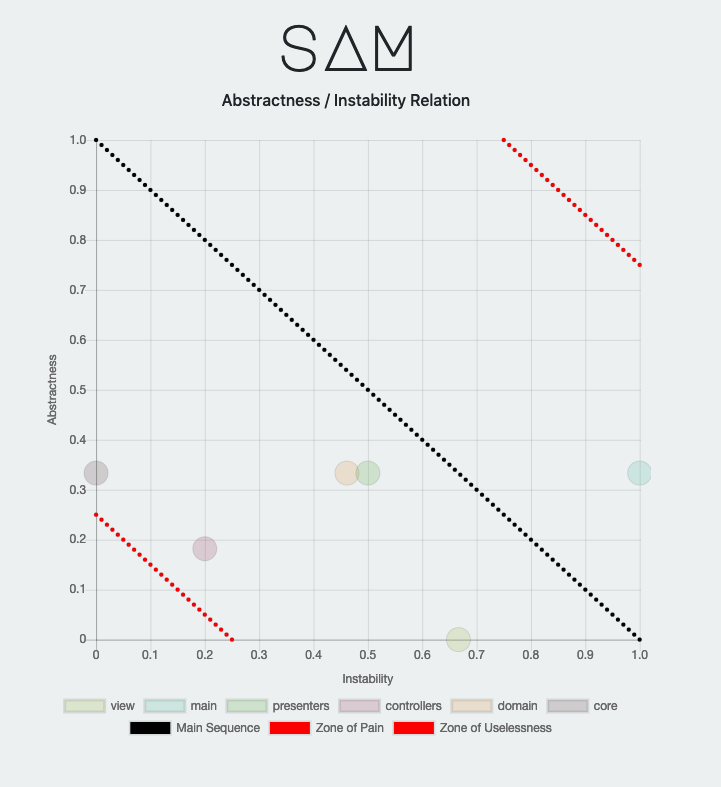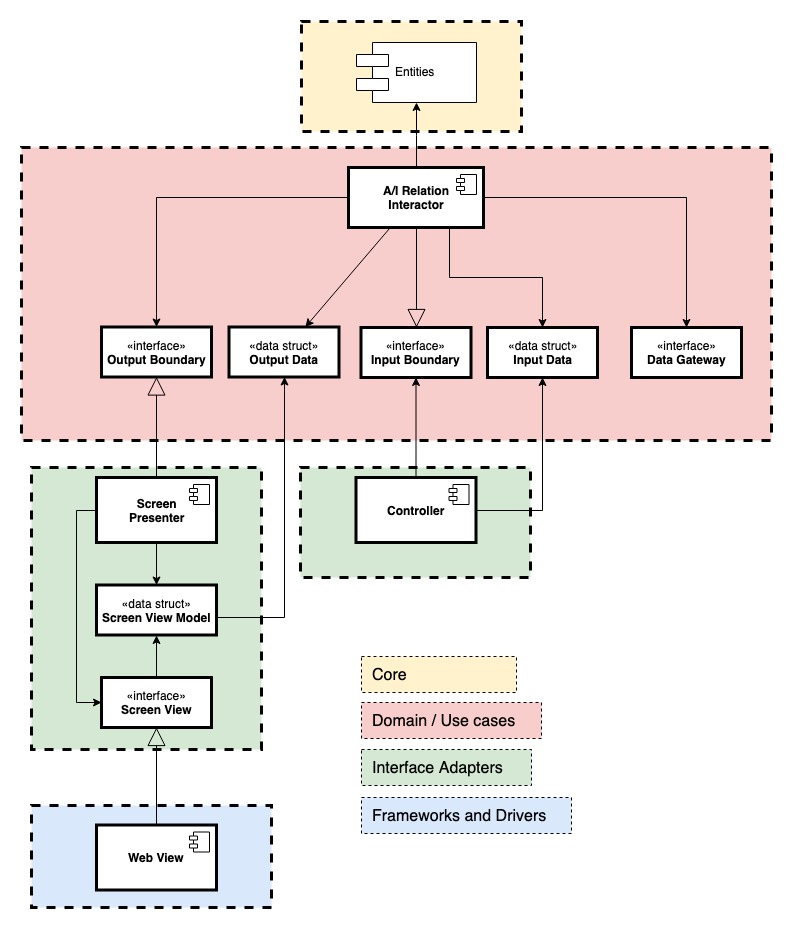SAM (Software Architecture Metrics) is a naive tool that analyzes Scala source code retrieving module-level metrics helpful to the software architect.
Download the distribution zip from the releases page and open it.
Open a new terminal window in the unzipped folder named sam-x.x.x and run bin/sam --help to show the usage instructions.
~$ bin/sam --help
sam 0.0.1
Usage: SAM [airelation] [options]
-o, --out <path> Specify the output path. Default is 'out'
Command: airelation [options]
Print out the Abstractness/Instability relation graph
-fn, --fName <value> Specify the output file name. Default is 'airelation.html'
-h, --help
The submitted modules are plotted into the Abstractness/Instability Graph showing the relation between each others.
The A/I Relation metric is defined as it is in the Clean Architecture book by Robert Martin.
Abstractness = Na / Nc
Na = Number of classes in the module
Nc = Number of abstract classes and interfaces in the module
Instability = fan-out / (fan-in + fan-out)
fan-in = Incoming dependencies
fan-out = Outgoing dependencies
The Instability metric works for the dependencies related to the submitted modules avoiding to consider the ones related to libraries or language specific in the calculation. Due to this make sure to submit all the modules that the software you want to analyze is made of.
SAM does not type check neither report compile errors. Please submit correct Scala code.
All the available metrics are listed as commands of the CLI executable.
SAM is a newborn and now provides only a single software architecture metric. If you want to suggest a metric just open an issue. You can also implement your own and contribute to the project.
SAM is developed following the Clean Architecture guidelines.
The core module provides the entities and the Scala source code analyzer.
It simply parse the code retrieving the AST. It should not be modified.
The domain module contains the interactors (use cases).
Each metric should be a use case that operate with the entities and the analyzer.
Basically a use case traverse the AST, retrieve information and calculate the metric.
Here an example from the AIRelationInteractor:
private class AIRelationTraverser(module: Component) extends Analyzer.Traverser{
private var packages = Set[String]()
private var imports = Set[Analyzer.Import]()
private var numClasses = 0
private var numAbstractClasses = 0
override def traverse(tree: Analyzer.Tree): Unit = tree match {
case Analyzer.ModuleDef(mods, name, impl) =>
numClasses += 1
super.traverse(impl)
case Analyzer.ClassDef(mods, name, tparams, impl) =>
if (mods.hasFlag(Analyzer.Flag.ABSTRACT))
numAbstractClasses += 1
numClasses += 1
super.traverseTrees(tparams)
super.traverse(impl)
case node @ Analyzer.Import(expr, selectors) =>
imports += node
super.traverse(expr)
case node @ Analyzer.PackageDef(pid, stats) =>
packages += pid.toString()
super.traverseTrees(stats)
super.traverse(pid)
case _ => super.traverse(tree)
}
def analizedModule: AnalizedModule = AnalizedModule(module, packages, imports, numClasses, numAbstractClasses)
}
val ast = Analyzer.parseCode(module)
val traverser = new AIRelationTraverser(module)
traverser.traverse(ast)Adding a metric means adding an interactor, the boundaries interfaces and the input/output data structures
to the domain module in a new sub-package.
The controllers and presenters modules depend on domain. A new metric needs
the related code in these modules.
The view code implements what the presenter describe about the metric information.
It is the output the user see (text, an image, an HTML page, etc...)
SAM is my first approach to Scala as a project for the Languages and Computational Models course at University of Bologna.
Matteo Pellegrino - matteo.pelle.pellegrino<@>gmail.com - @mttpll
Copyright (c) 2019 Matteo Pellegrino Permission is hereby granted, free of charge, to any person obtaining a copy of this software and associated documentation files (the "Software"), to deal in the Software without restriction, including without limitation the rights to use, copy, modify, merge, publish, distribute, sublicense, and/or sell copies of the Software, and to permit persons to whom the Software is furnished to do so, subject to the following conditions:
The above copyright notice and this permission notice shall be included in all copies or substantial portions of the Software.
THE SOFTWARE IS PROVIDED "AS IS", WITHOUT WARRANTY OF ANY KIND, EXPRESS OR IMPLIED, INCLUDING BUT NOT LIMITED TO THE WARRANTIES OF MERCHANTABILITY, FITNESS FOR A PARTICULAR PURPOSE AND NONINFRINGEMENT. IN NO EVENT SHALL THE AUTHORS OR COPYRIGHT HOLDERS BE LIABLE FOR ANY CLAIM, DAMAGES OR OTHER LIABILITY, WHETHER IN AN ACTION OF CONTRACT, TORT OR OTHERWISE, ARISING FROM, OUT OF OR IN CONNECTION WITH THE SOFTWARE OR THE USE OR OTHER DEALINGS IN THE SOFTWARE.

